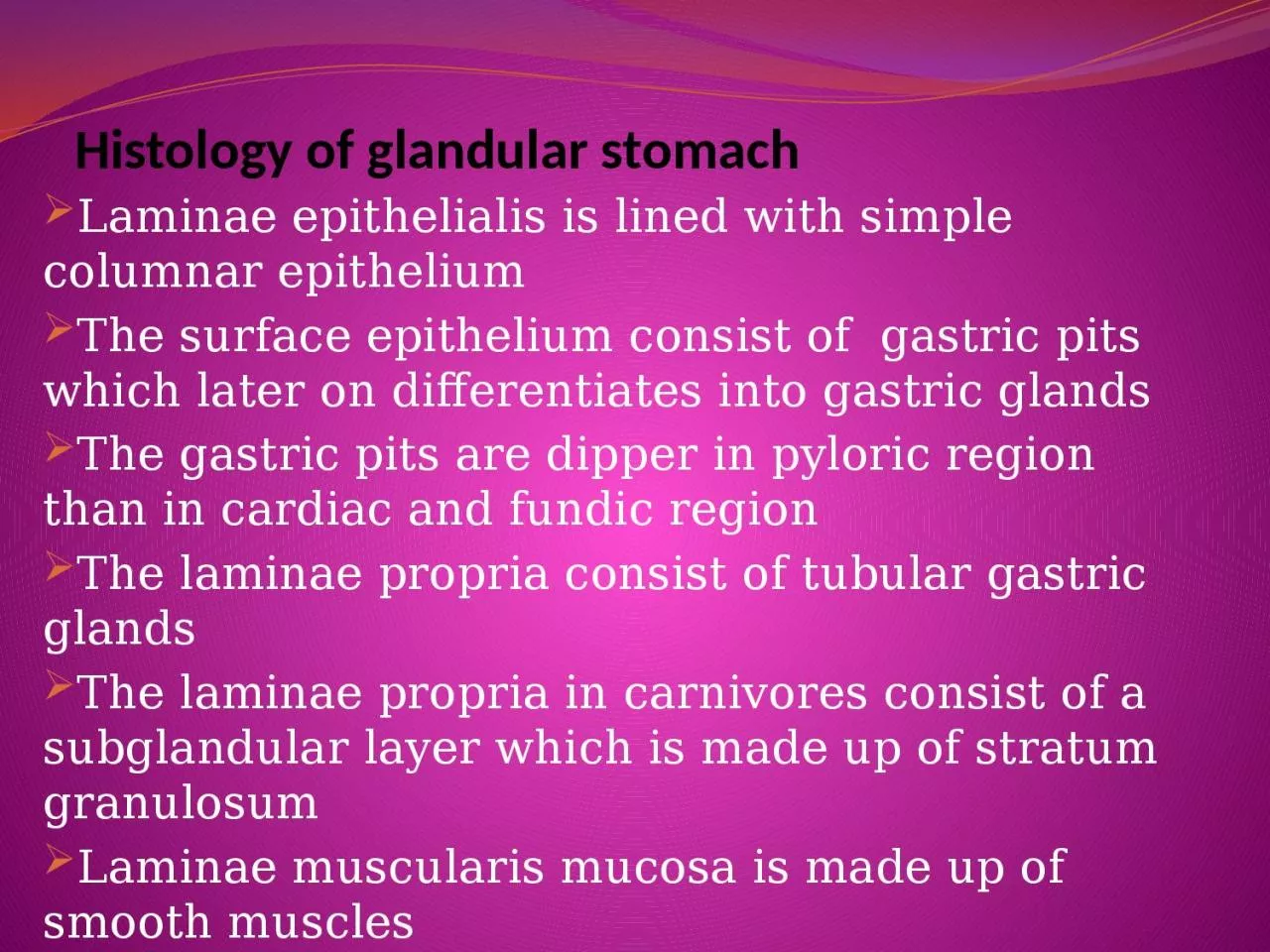

Laminae epithelialis is lined with simple columnar epithelium The surface epithelium consist of gastric pits which later on differentiates into gastric glands The gastric pits are dipper in pyloric region than in cardiac and ID: 1022915
Download Presentation The PPT/PDF document "Histology of glandular stomach" is the property of its rightful owner. Permission is granted to download and print the materials on this web site for personal, non-commercial use only, and to display it on your personal computer provided you do not modify the materials and that you retain all copyright notices contained in the materials. By downloading content from our website, you accept the terms of this agreement.
1. Histology of glandular stomachLaminae epithelialis is lined with simple columnar epitheliumThe surface epithelium consist of gastric pits which later on differentiates into gastric glandsThe gastric pits are dipper in pyloric region than in cardiac and fundic regionThe laminae propria consist of tubular gastric glandsThe laminae propria in carnivores consist of a subglandular layer which is made up of stratum granulosumLaminae muscularis mucosa is made up of smooth muscles
2. The glandular part of the stomach is divided into three areas mainly cardiac,fundic and pyloricThe cardiac area presents cardiac glands distributed in laminae propria which are simple branched coiled tubular gland of mucous secreting natureThe fundic area consist of true gastric glands whose glandular epitheliuum is made up of four varieties of cells mainly mucous neck cell,chief cells,parietal cells and endocrine cellsMucous neck cells,chief cells and parietal cells function like exocrine glandsMucous neck cells are distributed at the neck and upper part of body of fundic gastric glands and in pig they are also distributed at the base of the gland
3. Chief cells are numerous having pyramidal or columnar shape distributed in body and base of the gland and consist of basophilic granules known as zymogen granulesThe parietal cells are triangular or polyhedral cells which are placed peripheral to the chief cellsThey are known as Hcl secreting cells and the nucleus is spherical and is basally placedThe endocrine cells are known as argentaphin cells or enterochromaffin cellsThese cells are responsible for secretion of secretin/gastric inhibitory factors which are transported to the underlying vascular channel
4. The pyloric part of the stomach is typed as simple coiled branched tubular glands which are lined with mucous secreting cellsThe tela submucosa is made up of loose connective tissue containing submucosal plexus,blood vessels,lymph vessels and lymph nodulesTunica muscularis is made up of smooth muscle cells arranged in inner circular and outer longitudinal layerTunica serosa is lined with mesothelium
5. Tunica mucosa of glandular stomach
6. Tunica submucosa of glandular stomach
7. Tunica serosa of glandular stomach
8. Histology of intestineThe tunica mucosa is thrown into finger like mucosal folds called intestinal villiIn between the two intestinal villi the straight tubular intestinal glands descend in the lamina propria popularly known as glands of liberkuhnThe lminae epithelialis is lined with simple columnar epithelium whose epical border consist of numerous microvilli to produce striated borderThese are responsible to increase the surface area of absorptionThe surface epithelium presents random distribution of goblet cells which are not distributed at the tip of villiThe number of goblet cells increases from cranial to caudal end of small intestine
9. Diagram of villi
10. Section of small intestine
11. Laminae propria is made up of loose CT which extends upto central core of villi.It also consist of simple straight tubular glands known as mucosal glands of intestine or glands of Lieberkuhn which opens into the lumen of intestine near the base of intestinal villiThe glands are lined with undifferentiated columnar cells with few goblet cells.At the base of these glands in case of horse and ruminants there are few specialised pyramidal cells known as Paneth cellThe paneth cells are bacteriocidal and are responsible for production of peptidase and lysozymeLaminae muscularis mucosae is made up of smooth muscle arranged in two layers
12. Section of small intestine
13. The telasubmucosa in the cranial segment of the intestine consist of simple tubulo alviolar glands of serous,mucous or seromucous in variety in different animals popularly known as brunner’s glandThese glands open at the base of intestinal villi.In horse the entire duodenum and cranial jejunum consist of Bruner’s gland and in ox it is situated in the cranial part of duodenumIleum presents lymph nodules in form of payer’s patches which opens into the lumen of intestineTunica muscularis is made up of inner circular and outer longitudinal musclesTunica serosa is lined with mesothelium
14. Section of small intestine
15. Large intestineAbsence of intestinal villiAbsence of Paneth cellsAbsence of submucosal glandsLaminae muscularis mucosa not well developedLarge number of lymph nodulesHigher population of goblet cellsPresence of Taenia caeci and Taenia coli in horse and pig which are formed by condensation of outer longitudinal muscle layer of tunica muscularis